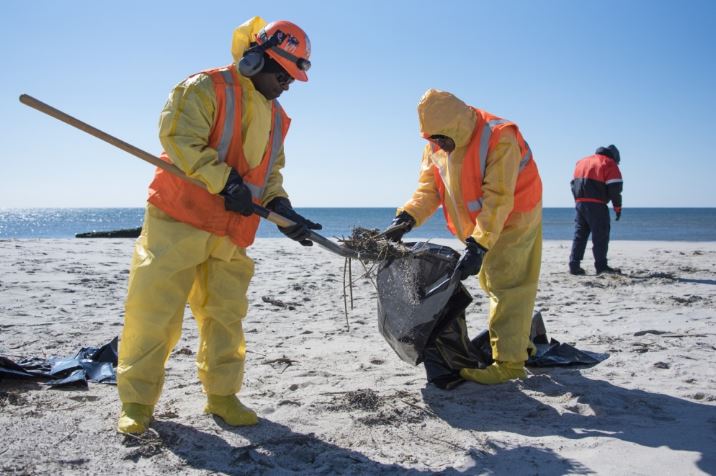A cleanup effort continued along New York and New Jersey shorelines after a containership with a 15” hole in one of its fuel tanks was identified as the source of an oil spill and tar balls found on beaches over the weekend.
The Coast Guard and New York Department of Environmental Conservation are investigating oil sheen and tar balls that appeared at Coney Island and along Long Island Oceanside beaches Saturday, and whether they are linked to a fuel leak that was detected March 28 at the Global container terminal on Staten Island.
The oil in the Arthur Kill waterway near the Goethals Bridge was traced to the 922’x102’x33’, 54,155-dwt Dublin Express, operated by Hapag-Lloyd, at the terminal. Coast Guard officials said the ship suffered a 15” hole in one of its fuel tanks with 300,000 gals. capacity. The leak was sealed, and causes of the damage and the amount of fuel oil spilled have not yet been determined by investigators, according to the Coast Guard. On Tuesday the Coast Guard's Marine Safety Laboratory completed a chemical fingerprinting of the recovered oil and verified it came from the Dublin Express.

Capt. Jason Tama, commander Sector New York and the Captain of the Port of New York and New Jersey, assesses the clean up operations of an oil spill in the Arthur Kill waterway in Staten Island, March 29, 2019. Coast Guard photo/Cmdr. Nicholette Vaughan
Crews from Coast Guard Sector New York, the Coast Guard Atlantic Strike Team, New York state environmental workers and contractors responded to the beach wash-ups.
Cleanup teams worked along the Elizabethport Reach of Arthur Kill including the Elizabeth Marina in New Jersey, and Jacob Riis Park in New York. Others worked at Rockaway Beach, N.Y., Monday cleaning up tar balls that shoreline cleanup and assessment technique (SCAT) teams found Sunday. A total of 87 people along with 16 boats were working, according to the Coast Guard's unified command.
Teams have surveyed the New Jersey coast from Long Beach to Sandy Hook, Raritan Bay, and New York including Staten Island, Brighton Beach, Gravesend Bay, Rockaway Beach, Long Beach, and Jones Beach from the air and on foot and found little to no oil observed. Based on technical advice from the National Oceanic and Atmospheric Administration's tide and currents analysis, the responders do not anticipate any more oil coming ashore further south.
“We’ve seen a lot of progress in the cleanup of the Arthur Kill Waterway, and we continue to work with our Unified Command partners to ensure a rapid and thorough cleanup of all impacted areas,” said Capt. Jason Tama, commander of Coast Guard Sector New York and the incident coordinator. “Our priorities continue to be the safety of everyone involved including the public and responders, and environmental cleanup.”
With warming spring weather, New York and New Jersey state environmental officials cautioned beachgoers and waterway users to avoid contact with the tar balls and report sightings to authorities. But the only casualties reported by Monday night were two ring-billed gulls and a duck fouled with oil and picked up by animal rescuers.





